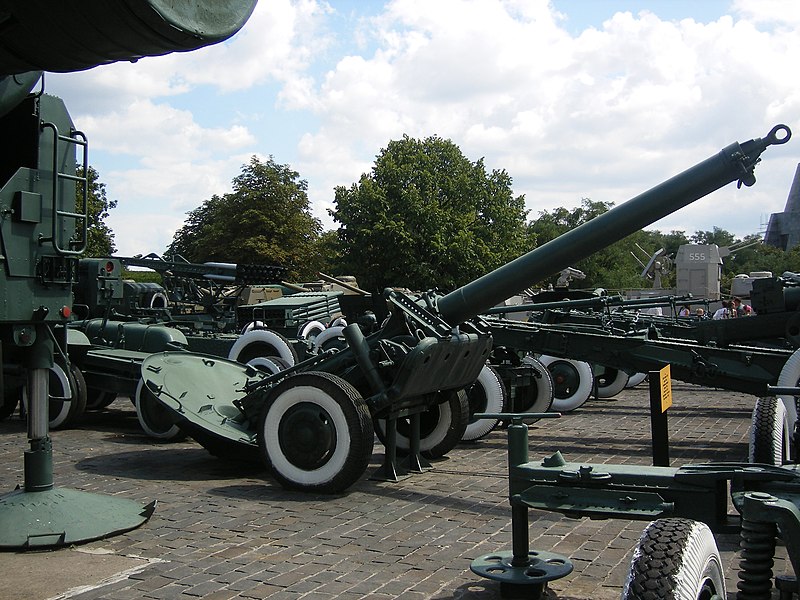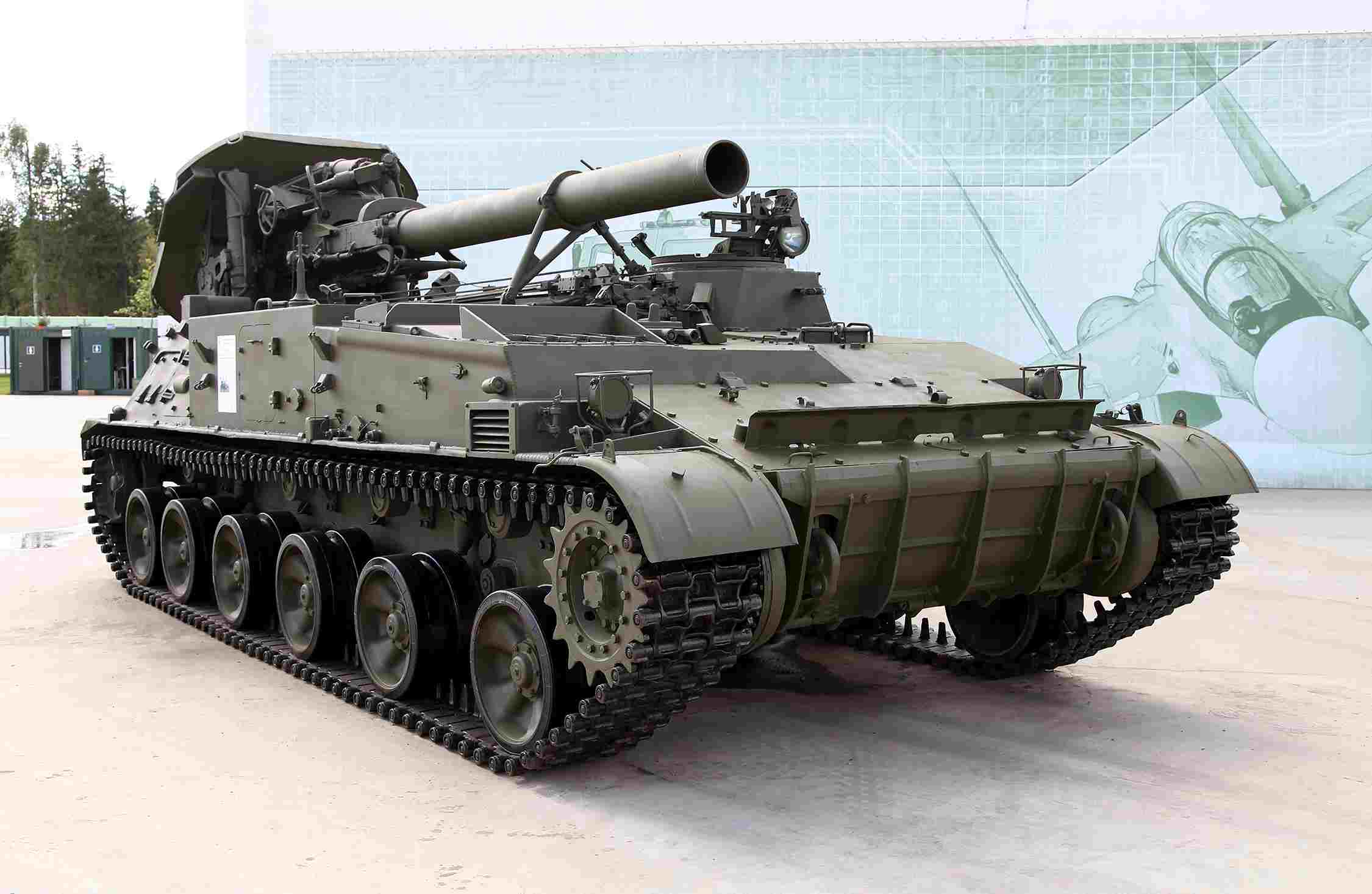The ongoing conflict in Ukraine has brought back into use some weapons produced back in the late 1960s and 80s by the erstwhile Soviet Union. One such weapon is the 240mm M-240 towed mortar.
A video emerged last week, showing the Ukrainian armed forces using the 240-millimeter M-240(s). The troops in the video are reportedly from the Ukrainian navy’s 35th Marine Brigade stationed near Marinka in eastern Ukraine’s Donbas region.
According to military commentators, it is a mystery where the Ukrainians got their M-240(s) because it was not previously known to be in long-term storage by the Ukrainians. Also, little is known about which types of ammunition they are firing using their M-240(s).
This is probably the second documented instance of Ukrainian forces using the M-240 mortar. Before this, an image had surfaced in September last year showing an M-240 firing a mortar round.
Until then, the only example of the giant mortar that anybody outside of the Ukrainian military had seen in Ukraine was in a museum in Kyiv.
#Ukraine: Footage of the Ukrainian 35th Marine Brigade again firing the old and very powerful M-240 240mm mortar, this time using RAP ammunition – either the 3F2 HE-Frag or 3O8 cargo mortar bombs.
These have a range of up to ~20km. https://t.co/V5bvYKXazk pic.twitter.com/loZWn2rlix
— ?? Ukraine Weapons Tracker (@UAWeapons) February 3, 2023
So, the Ukrainian military may have operationalized this museum piece unless decades-old ex-Soviet M-240s were being stored in a concealed location somewhere in Ukraine.
Another possibility is that one of Kyiv’s partners, such as Romania or the Czech Republic, may have donated one or more of their own M-240s to the Ukrainian military.
The M-240 Towed Mortar
The M-240 mortar is known for its mighty punch that can take out fortified buildings, bunkers, airport runways, etc. However, it lacks range and has a very low rate of fire of only one round per minute.
The Soviet-era Uraltranmash is known to have manufactured hundreds of towed and self-propelled M-240s between the late 1960s and late 80s.
Notably, the Soviet-era 2S4 Tyulpan 240mm mortars that Russia used widely during its seizure of the Azovstal complex in the eastern Ukrainian city of Mariupol last year are also derived from the M-240 mortar.

Just like the M-240, even the 2S4 has a minimal range and can shoot just one round per minute. Also, the M-240 and the 2S4 require a large crew of up to 9-11 people, according to varying accounts. However, the 2S4 is somewhat agile compared to the M-240, whose sluggishness makes it vulnerable to hostile artillery fire.
The M-240 can fire huge 221-pound (roughly 100kg) F864 high explosive projectiles, measuring 1.5 meters in length and comparable in weight to small aerial bombs, at targets up to a range of nine kilometers. With rocket-assisted projectiles, the range of fire can be increased up to 20 kilometers.

Unlike the rounds fired by a howitzer, a mortar round descends on a target in a near-vertical trajectory. It is therefore considered effective for use against the walls of fortifications and roofs of buildings or to shoot down into cave mouths or on the far sides of mountains.
Also, the M-240 mortar can deploy a variety of special-purpose rounds for such pursuits, such as concrete-piercing shells to shatter bunkers or Sayda incendiary projectiles to set buildings on fire.
Laser-Guided Smel’chak ‘Daredevil’ Munitions
The M-240 can also fire the laser-guided 3F5 high-explosive projectiles called ‘Smel’chak’ – Russian for ‘Daredevil’ – rounds. The Soviet army is known to have first used these rounds in Afghanistan in 1985.
A senior American military analyst, Dr. Lester W. Grau, described in a 2006 study that the Soviet forces first fired two unguided rounds at a half-demolished fortress some 3,250 meters away to calibrate the mortar with the aid of a forward observation team on a mountain. After that, they fired a 3F5 round “which penetrated the roof of the fortress.”
“The fortress disappeared in a cloud of smoke, dust, and debris. The mission took 15 minutes,” wrote Grau.
The Russian forces have been observed firing a few 3F5s in Ukraine. However, there is no evidence that Ukraine has these laser-guided rounds. Assuming the Ukrainian forces may have activated a museum piece, they are unlikely to have access to 3F5s.
It seems against ukranian forces on "Azovstal" there use this 240mm guided mortar round "Smelchak". Such accuracy is needed if known where the weak points of the shelters at Azovstal are or to destroy the entrancesexists from these shelters. pic.twitter.com/gkQ8abQVEO
— Yuri Lyamin (@imp_navigator) May 13, 2022
Ukrainian forces reportedly captured a stock of Russian 240-millimeter mortar bombs during their surprise northern counteroffensive, which forced a hasty withdrawal of Russian troops from the Kharkiv region. This stock could have included a few 3F5s.
However, only having the laser-guided rounds is not enough, as actually employing them will entail a fair amount of supporting equipment which includes the 1D15 laser designator and the 1A35 shot synchronization system—comprising of the 1A35K command device (at the firing position) and the 1A35I forward observation post device.
After calibrating the mortar with unguided rounds, the crew fires a 3F5. The 1A35 shot synchronization system is activated between the firing position and the forward observation post, which triggers the 1D15 laser designator and paints the target for the incoming round.
So, unless the Ukrainians also had the necessary supporting equipment stashed in a museum or some obscure warehouse, or their partners donated these systems, the marines must be shooting unguided rounds from their massive mortar(s).
Other Vintage Weapons Deployed By Ukraine
Several other vintage weapons, which date back to World War 2 or earlier, are being deployed by the Ukrainian forces in their ongoing conflict against the invading Russian forces.
These include the Pulemyot Maxima 1910 machine gun (or PM M1910), and the US-made M101 towed howitzers produced in the 1940s and early 50s.
The Imperial Russian Army used the M1910 during World War 1 (WW1) and the Red Army during the Russian Civil War and WW2. It was derived from the original Maxim, the world’s first fully automatic machine gun, created in 1884 by British-American inventor Hiram Maxim.
Imperial Russia acquired these guns from Germany and Britain, which proved to be quite effective during the 1904-1905 Russo-Japanese war, after which the decision was made to manufacture them in Russia. However, manufacturing did not start until 1910.
Videos and images began emerging in May, showing the M1910 Maxim machine gun used by Ukrainian forces to resist the invading Russian military.
#Ukraine: Tachankas of the Ukrainian army – a Maxim M1910/30 7.62x54R machine gun installed on a Soviet LuAZ-969 amphibious vehicle and operated by the Territorial Defense of #Zaporizhzhia.
TDF units are usually badly mechanized, so this is a way to increase firepower. pic.twitter.com/r5m0xVXTVC— ?? Ukraine Weapons Tracker (@UAWeapons) May 25, 2022
The Russian media reportedly mocked Ukraine for using century-old equipment, implying that the country was running short of modern weapons. An Economist article reported that Ukrainian forces were using the M1910 machine gun by choice and not because of the lack of modern equipment.
While the M1910 is significantly bulkier than most modern guns with a weight of 68 kilograms and offers a much lesser firing rate of only 600 rounds per minute, it has something that makes it uniquely suitable for use in modern-day warfare: a water-cooling system.
Modern medium machine guns firing similar 7.62mm rounds as the M1910 carry a fraction of the weight and are more portable. However, they lack water cooling, and firing continuously, even for a minute, can cause them to overheat, leading their barrels to deform or possibly even causing the ammunition to explode prematurely.
The M1910’s barrel, because of its unique water-cooling system, can continuously fire for extended periods. Apart from that, the M1910’s fixed mounts make them easier to aim.
The M1910 is said to be effective in fixed defensive positions and fortifications. In 2016, a Ukrainian soldier said in an interview that the gun was highly accurate at one kilometer and effective up to three kilometers.
Some of the M1910s have also been modernized, with images circulating on social media of the century-old machine guns equipped with modern electronic red dot sights.
MadMax Steampunk LMG in Ukraine
Twin linked 7.62mm Russian made PM M1910 machine guns (from 1910-1945 !) fitted with Red Dot sight pic.twitter.com/Vw62WOeqXP— Harry Boone (@Harry_Boone) March 26, 2022
Apart from Ukrainian armed forces, Russian separatists in the Donbas region also use the M1910. Examples of guns have also emerged in other conflict zones like Syria and Vietnam.
- Contact the author at tanmaykadam700@gmail.com
- Follow EurAsian Times on Google News




